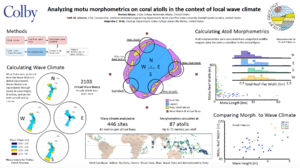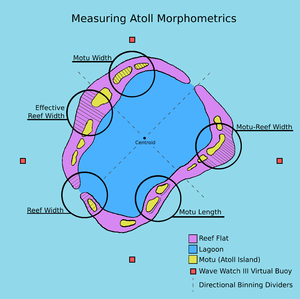2021 CSDMS meeting-094: Difference between revisions
From CSDMS
No edit summary |
No edit summary |
||
| (4 intermediate revisions by 2 users not shown) | |||
| Line 43: | Line 43: | ||
{{CSDMS meeting abstract template 2021 | {{CSDMS meeting abstract template 2021 | ||
|CSDMS meeting abstract=Throughout the world’s oceans, there are hundreds of coral atolls. These structures provide valuable habitats to plants and wildlife, and the islands on them are home to hundreds of thousands globally. Atoll islands, known as motu, are geologically quite young; they form relatively quickly, over hundreds or thousands of years. While there has been significant work in studying the effect of ocean waves on coastal morphologies, there is little such work specifically focusing on coral atolls and the motu upon them. In this study, we examine the morphologies and morphometrics of over 80 atolls in the Indian and Pacific oceans and quantify the morphometrics of the reef flats and motu with direction-based binning. We gathered recent ocean wave data from over 600 locations around these atolls using NOAA’s Wave Watch III simulations and quantified the local wave climate for each of our atolls. After analyzing these two separate datasets, we compared the effect of local wave climate on atoll morphology. In our analysis, we have found regional trends in wave climate, specifically we have observed directional differences in wave size prevalence between the wet and dry seasons. We have also noted possible relationships between reef width and wave height and between motu width and the 50 year wave height. As we continue to investigate these data, these findings will allow us to better understand the processes driving motu evolution and may be used to infer potential morphological changes in the presence of changing wave climates. | |CSDMS meeting abstract=Throughout the world’s oceans, there are hundreds of coral atolls. These structures provide valuable habitats to plants and wildlife, and the islands on them are home to hundreds of thousands globally. Atoll islands, known as motu, are geologically quite young; they form relatively quickly, over hundreds or thousands of years. While there has been significant work in studying the effect of ocean waves on coastal morphologies, there is little such work specifically focusing on coral atolls and the motu upon them. In this study, we examine the morphologies and morphometrics of over 80 atolls in the Indian and Pacific oceans and quantify the morphometrics of the reef flats and motu with direction-based binning. We gathered recent ocean wave data from over 600 locations around these atolls using NOAA’s Wave Watch III simulations and quantified the local wave climate for each of our atolls. After analyzing these two separate datasets, we compared the effect of local wave climate on atoll morphology. In our analysis, we have found regional trends in wave climate, specifically we have observed directional differences in wave size prevalence between the wet and dry seasons. We have also noted possible relationships between reef width and wave height and between motu width and the 50 year wave height. As we continue to investigate these data, these findings will allow us to better understand the processes driving motu evolution and may be used to infer potential morphological changes in the presence of changing wave climates. | ||
|CSDMS meeting posterPDF=Bentley_Meyer_CSDMS_Poster.pdf | |||
|CSDMS meeting posterPNG=Bentley_Meyer_CSDMS_Poster.png | |||
}} | }} | ||
{{CSDMS meeting abstract figures | {{CSDMS meeting abstract figures | ||
|CSDMS meeting abstract figure=Atoll Analysis Methods Diagram.png | |CSDMS meeting abstract figure=Atoll Analysis Methods Diagram.png | ||
|CSDMS meeting abstract figure caption=In this project we analyzed coral atolls<br>by measuring effective reef width,<br>reef width, motu width, motu length,<br>and reef-motu width. These measurements were<br>binned based on cardinal<br>direction from the atoll centroid. We analyzed<br>these metrics in comparison to<br>directionally-binned wave climate data<br>gathered and analyzed from<br>Wave Watch III virtual buoys. | |CSDMS meeting abstract figure caption=In this project we analyzed coral atolls<br>by measuring effective reef width,<br>reef width, motu width, motu length,<br>and reef-motu width. These measurements were<br>binned based on cardinal<br>direction from the atoll centroid. We analyzed<br>these metrics in comparison to<br>directionally-binned wave climate data<br>gathered and analyzed from<br>Wave Watch III virtual buoys. | ||
}} | }} | ||
{{blank line template}} | {{blank line template}} | ||
Latest revision as of 08:42, 19 May 2021
Log in (or create account for non-CSDMS members)
Forgot username? Search or email:CSDMSweb@colorado.edu
Browse abstracts
Analyzing motu morphometrics on coral atolls in the context of local wave climate
Bentley Meyer, Colby College Waterville Maine, United States. bmmeye21@colby.edu
Faith M. Johnson, Civil, Construction, and Environmental Engineering Department, North Carolina State University Raleigh North Carolina, United States.
Alejandra C. Ortiz, Geology Department, Colby College Waterville Maine, United States. acortiz@colby.edu
Throughout the world’s oceans, there are hundreds of coral atolls. These structures provide valuable habitats to plants and wildlife, and the islands on them are home to hundreds of thousands globally. Atoll islands, known as motu, are geologically quite young; they form relatively quickly, over hundreds or thousands of years. While there has been significant work in studying the effect of ocean waves on coastal morphologies, there is little such work specifically focusing on coral atolls and the motu upon them. In this study, we examine the morphologies and morphometrics of over 80 atolls in the Indian and Pacific oceans and quantify the morphometrics of the reef flats and motu with direction-based binning. We gathered recent ocean wave data from over 600 locations around these atolls using NOAA’s Wave Watch III simulations and quantified the local wave climate for each of our atolls. After analyzing these two separate datasets, we compared the effect of local wave climate on atoll morphology. In our analysis, we have found regional trends in wave climate, specifically we have observed directional differences in wave size prevalence between the wet and dry seasons. We have also noted possible relationships between reef width and wave height and between motu width and the 50 year wave height. As we continue to investigate these data, these findings will allow us to better understand the processes driving motu evolution and may be used to infer potential morphological changes in the presence of changing wave climates.


